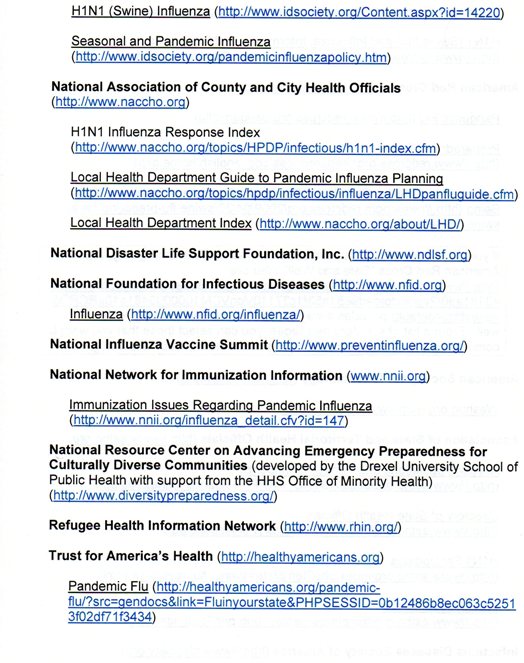Forearmed you can break the chain of spread!
H1N1 is the ‘novel’ virus that was responsible for the ‘swine flu’ outbreak earlier this year.
It is a subtype of Influenza A but not following the ‘rules’-what this means is that the screening test done in the doctor’s office and the emergency department may test negative and you can have H1N1. Accurate presence of H1N1 can only be determined in special labs and this testing is reserved for very ill hospitalized individuals. This is not the ‘seasonal flu that you get the annual flu shot for! Both viruses are very familiar in the way they make us ill: cough and/or sore throat, fever greater than 100° F (37.8 °C) muscle aches in many places.
GOOD NEWS
In most cases the person will recover if rest, fluids, control of fever and TIME occur.
The international medical community is calling it a pandemic, spread over continents and defined by when more than 80/100,000 cases exist in a country. Pandemic occur rarely due to a new virus popping up. Therefore most people will have little or no immunity.
Worldwide development of a vaccine being rushed, but likely it will reach us in the early stages of the pandemic. Dependent on timing of its release you may benefit from taking the H1N1 vaccine. The seasonal flu vaccine although important to get will not protect against H1N1 illness.
The current H1N1 vaccination recommendation prioritizes five key populations. When vaccine is first available, the following are to be vaccinated first:
- pregnant women,
- people who live with or care for children younger than 6 months of age,
- health care and emergency medical services personnel,
- persons between the ages of 6 months through 24 years of age, and
- people from ages 25 through 64 years who are at higher risk for novel H1N1 because of chronic health disorders or compromised immune systems.
The groups listed above total approximately 159 million people in the United States. The expect release of 43 million vaccines Oct 15 with more to follow. There will be 90,000 sites nationwide administering the vaccine.
IMPORTANT: The novel H1N1 vaccine is not intended to replace the seasonal flu vaccine. It is intended to be used alongside seasonal flu vaccine to protect people. Seasonal flu and novel H1N1 vaccines may be administered on the same day.
Antiviral medication if effective may be in great demand and therefore limited supply.
THE NUMBERS
Seasonal flu causes 200,000 hospitalizations and 36,000 deaths. 100million Americans get seasonal flu shots annually
Pandemic Influenza (H1N1) projections:
90 million in the US will be infected
9.9 million Hospitalized
1.9 million Deaths
It will take approximately 5 weeks to spread across the US and 6-8 weeks to recede.
More than 50% of those that become ill will seek medical attention.
YOUR RESPONSIBILITY
Break the chain of spread!
- Washing hands Well, Note gel wash (alcohol based) will kill the virus after 15 seconds
- Practice Cough etiquette
- Get the Seasonal Flu Vaccine
- Identify folks in your community that are vulnerable: stuck at home sick with other illness, cancer
- Establish social networks rather than go to place of worship use Facebook, Twitter for social updates
- If ill separate yourself from others
- Stay at home- if have flu symptoms, no school for ill children
- Do not return to exposing others till you have been totally well for at least 24 hours straight!
- Ask employer to work from home
WARNING SIGNS
For children, signs that medical attention is needed include:
- Fast breathing or trouble breathing
- Bluish or gray skin color
- Not drinking enough fluids, dark urine or little urine
- Severe or persistent vomiting
- Not waking up or not interacting normally
- Being so irritable that the child does not want to be held
- Flu-like symptoms improve then return with fever and worse cough
For adults, signs that medical attention is needed include:
- Flu-like symptoms improve but then return with fever and worse cough
- Difficulty breathing or shortness of breath
- Pain or pressure in the chest or abdomen
- Sudden dizziness
- Confusion
- Severe or persistent vomiting
RECOMMENDATIONS
FOR TESTING:
Only high risk individuals those with underlying medical problems, pregnant patients
And patients over 65 and younger than 2 years of age
FOR PREVENTIVE H1N1 VACCINE
Immunity after vaccine begins to kicks in just eight to 10 days after the shot with full immunity after 3 weeks.
Side effects include soreness or redness at the injection site, and some fever.
One inoculation will after 10 days protect you form becoming ill from exposure to this virus
PREVENTIVE ANTIVIRAL MEDICATIONS
Is only for severely ill patients and those at risk for complications if they caught the virus.
At this posting the strain of H1N1 is sensitive to Oseltamivir (Tamiflu) and Zanamivir (Relenza)
Know that viruses mutate and can become resistant to the antiviral medications, there has already been a case in Denmark of resistance to Oseltamivir. Fortunately the resistant strain was killed by Zanamivir.
Knowing what to do can help you stay in control and cope
Check out resources online








Recent Comments